Off the Grid: The emotions of an NFL locker room at season’s end

RENTON, Wash. — No physical metaphor sums up the end of an NFL season like the big box of cleats in the middle of a team’s locker room. If that one doesn’t work for you, there are the library-style book carts labeled for the return of the iPads the offensive and defensive players use to review their plays during the season. Or the mass of moving boxes strewn around, ready to be filled with the contents of each locker.
Time’s up, guys. Season’s over. Better luck next year. It happens to all but one NFL team every time around. That’s just part of the emotional toll—you fell short again, and you have a long season to think about why, and how you can get closer to the ultimate goal next time around.
For the Seahawks, whose two-year streak as the NFC champions came to an end last Sunday with a 31–24 loss to the Panthers in the divisional round of the playoffs, this finality was especially revealing. On Monday, these players who have accomplished so much went through the locker room between physicals and final team meetings, saying their goodbyes to each other and understanding that now, those goodbyes might be more permanent.
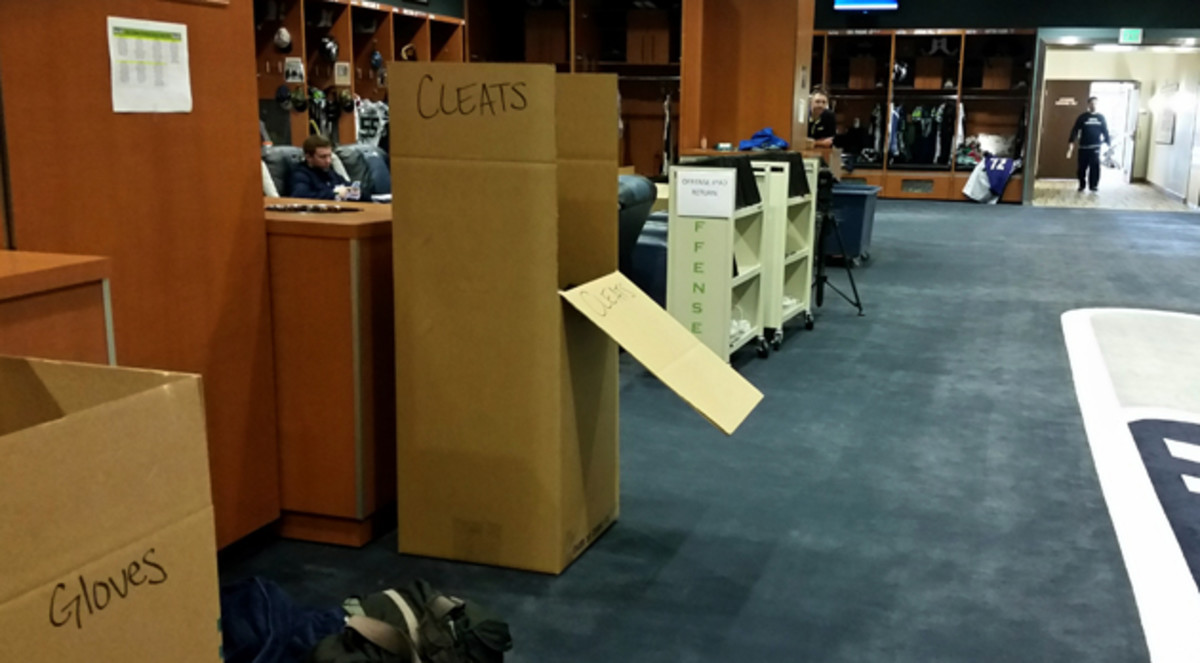
Marshawn Lynch walked through quickly and quietly after the fact, his usual indifference to the media intact. Rumors about his future with the team have run rampant—far more so than Lynch has this season. He saw injuries derail his ninth professional season as they never had before, he turns 30 on April 22, and he carries an $11.5 million cap hit for the 2016 season.
Receiver Jermaine Kearse, one of Seattle’s 19 unrestricted free agents coming into the new league year, packed up his locker as counterpart Doug Baldwin yelled over to him, “You better leave some of that stuff in there!”
Defensive end Cliff Avril walked through with his young son, looking tired one day after a game in which he suffered a neck injury. Avril was moving around all right, but you could see the season’s residue on his face. He accepted congratulations from teammates and media members on a great season that ended two games too soon for his taste.
“Future defensive end?” I asked Avril of his son.
“Nope. Future power forward.”
Not everyone is built for this particular grind. Avril picked up a rainbow coalition of jerseys—his own, and ones he had swapped with opponents over time—took his son in hand, and he was gone.
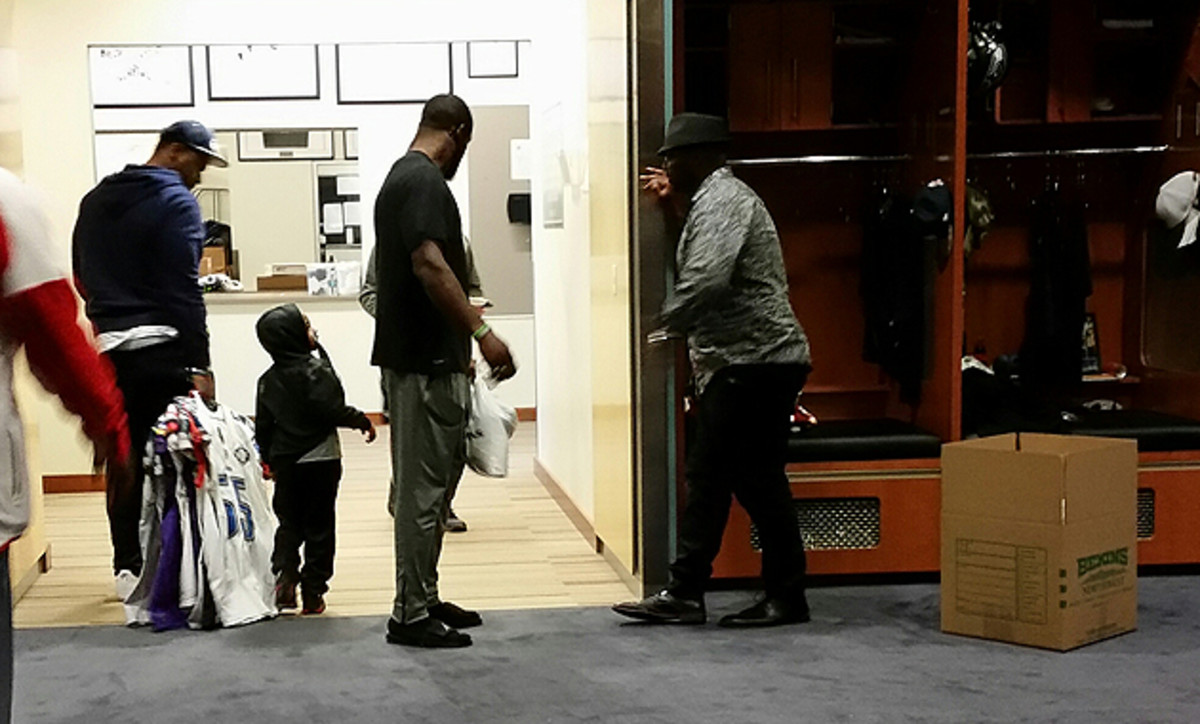
Meanwhile, linebacker Bruce Irvin, another upcoming free agent, spoke about his position in the team’s crucial 2012 draft class and said openly that he’d take a hometown discount to return—which undoubtedly had his agent doing a bit of day-drinking. Tight end Luke Willson, a backpack around his shoulder, picked up a mammoth and full moving box, and you could see the literal weight of the season on him. Defensive tackle Ahtyba Rubin wore a helmet with street clothes, as if the helmet could somehow delay the end of this. The first-year Seahawk had asked many of his teammates to sign it. Richard Sherman and Kam Chancellor commiserated near the locker room’s exit, where Avril and his son had been a few minutes before.
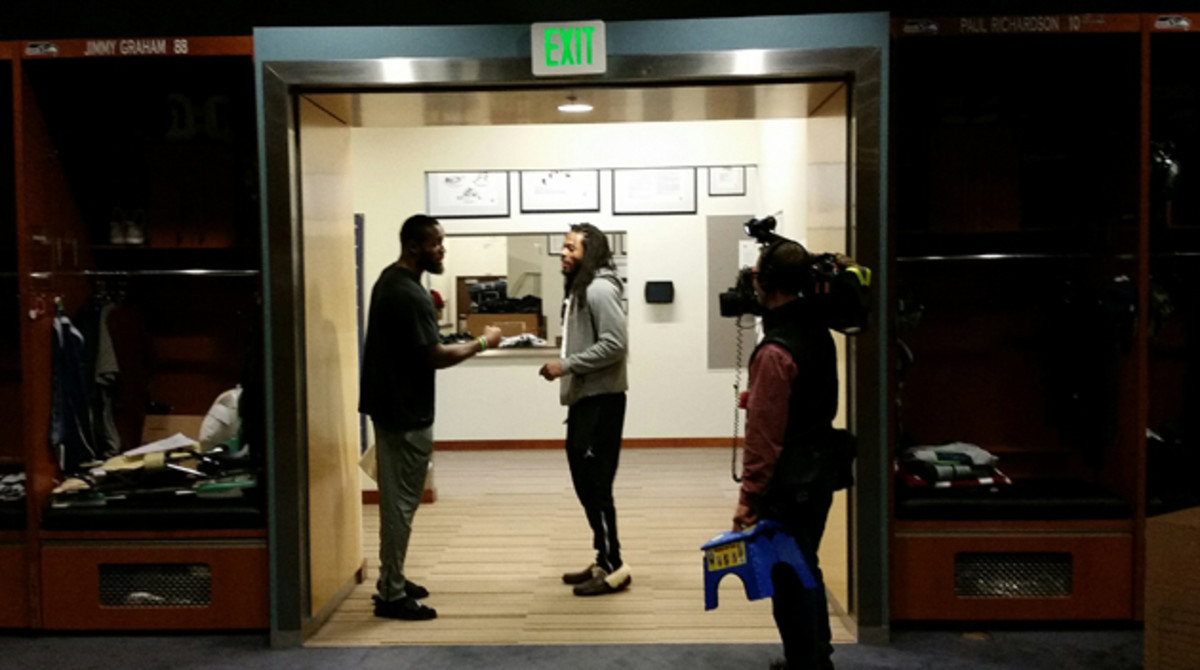
There are different ways to lose, and different ways to recover. After the Seahawks lost to the Falcons in the 2012 divisional round, then rookie Russell Wilson famously told Pete Carroll right away that next year would be different. It was—Seattle ground down the rest of the NFL with the league’s best defense and rushing attack, and crushed the Broncos in Super Bowl XLIII. The next season looked like more of the same once the team came alive after a 3–3 start, but the ending of Super Bowl XLIX—the most famous interception in the history of football’s biggest game—had more of a lasting effect than anyone was willing to admit. One day after his 2015 season ended, Carroll finally admitted it.
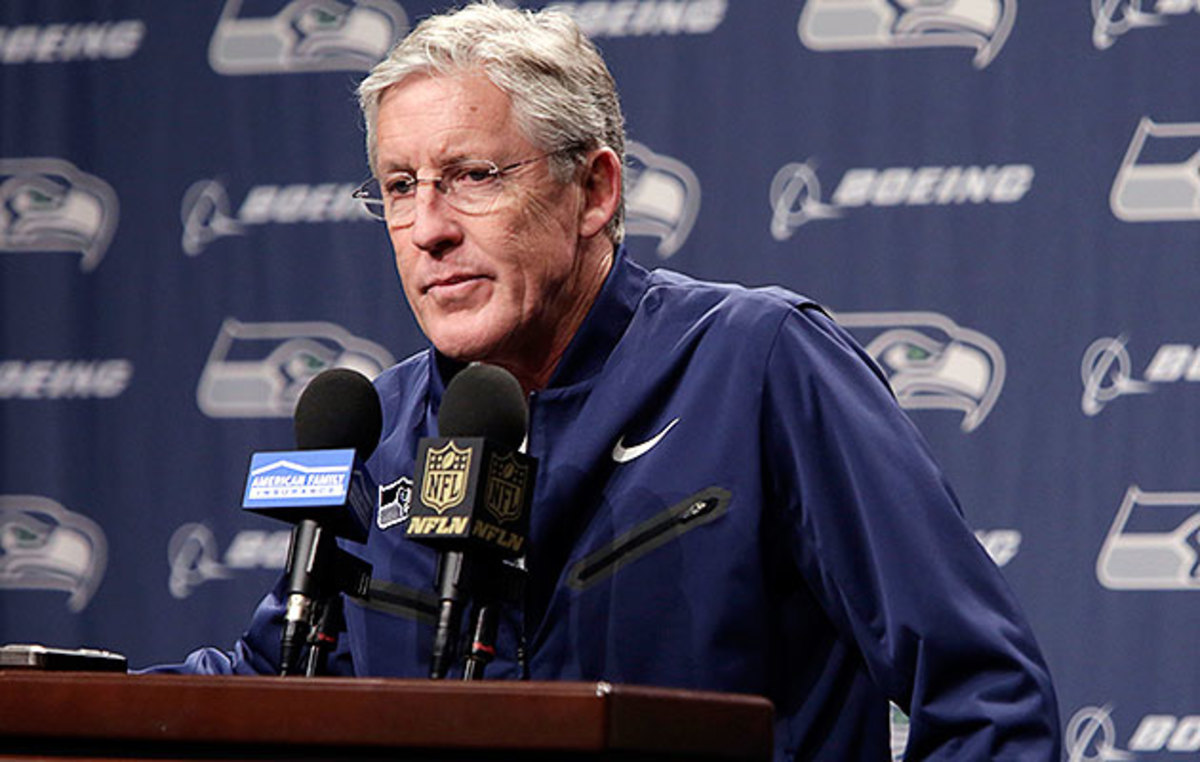
“Well, I was trying to not bring it to light any more than I had to, because I was working with it the whole time,” he said. “This was no surprise. I continue to remind you guys that it’s the same kind of bulk issue that you have to deal with when you win, too. You still have problems and concerns that serve as distractions that you have to push aside. We’ve been through it. We’ve really seen what that’s all about, and we’ve learned from it, and our players know. They know what we went through. We were actively working to clear our minds, and to clear our focus, and to get right, and it just took awhile.”
The ready list: How the Cardinals found key pieces in unlikely places
It took too long—the Seahawks got off to a 2–4 start in which the defense was a mess and the offense was even worse. The turnaround in the second half of the season, which saw Wilson become one of the league’s premier quarterbacks (29 touchdowns and five interceptions from Week 9 through the Carolina loss), wasn’t enough.
Now, it’s about how they recover. Will this be a return to the post-Atlanta scene, when Carroll and his charges went through the off-season pissed off and loaded for bear? Or will the specter of 2015’s missed opportunities add to the emotional scars of that last Super Bowl and capsize the whole thing? This is a young team with a ridiculous amount of talent and a seemingly wide window of opportunity over the next few years. But none of that will matter if Carroll can’t keep the wolves at bay—the voices in his players’ heads, and in his own.
Forget the team, I asked Carroll. How did this affect you?
“I took both of these opportunities as great challenges, and recognizing that they both have impact, and they both can be significant,” he said. “We’re already in that mode, now it’s already done, to try and start to regroup and get going again. Personally, that’s just what my job is. That’s just what I do. It doesn’t seem like it took any more toll or anything, I don’t feel like I’m worn down by it.
“I welcome it. I like it. I like the challenge of it. I like being challenged when you win and you’re on top and that kind of stuff and how hard that is to do that. I like that in particular. This year now, will be a little bit different. This is a little bit different ship that’s going to be sailing here. We’ll see what happens. I came out of the meeting with our guys today and I wish we could go do some more stuff. I wish we could keep playing, I wish we could keep working on it and getting better. I’m not ready to break. I feel fine.
Jackie Smith talks extensively about the drop that almost ruined his life
And then, something a little closer to the other side of a coach’s soul:
“That doesn’t help these guys who have been beating their heads against the wall for nine months.”
Baldwin, who benefited more than anyone from Wilson’s second-half turnaround, has always been one of the team’s more philosophical voices. “Angry Doug” was an undrafted afterthought who built himself into a Pro Bowl-potential player both outside and in the slot, and that has given him a great deal of currency in the locker room. How he deals with this will be crucial to the team’s future—it’s that way for the leaders on every team in the off-season.
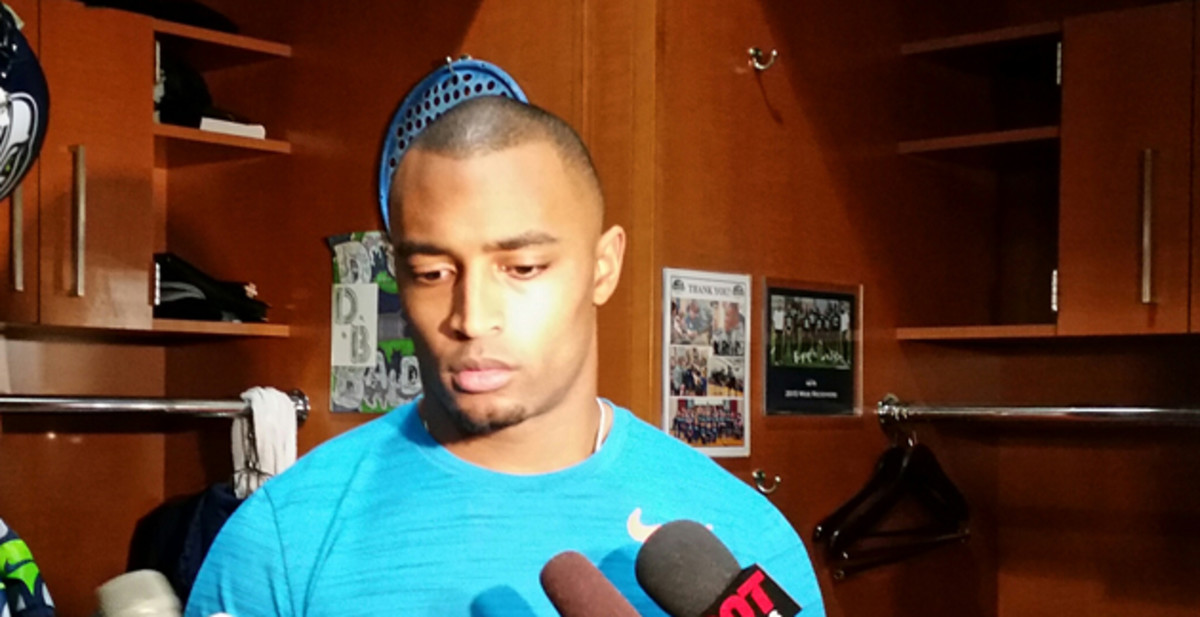
“The game of football is not forever,” Baldwin said. “We all have a limited amount of reps that we’re going to play in the NFL, a limited amount of time, and there’s so many things that are bigger than the sport of football. We want to win championships, but people have families. Spending time with them and enjoying that and having the peace of mind is much more important than the stresses that are placed on us because of the sport of football.”
And with that, the real journey begins. The journey back to normal, whatever that may be, for any NFL team that doesn’t win it all.
Q&A: Geoff and Mitchell Schwartz
Giants offensive lineman Geoff Schwartz was selected by the Panthers in the seventh round of the 2008 draft out of Oregon, and he’s parlayed his humble NFL beginnings into his current status as the starting right guard of the Giants—a position that was reinforced by the four-year, $16.8 million contract he signed with the team in 2014. Geoff’s 2015 season ended early with a broken leg, but he’s rehabbing for the upcoming season and has also started his own “Block ’Em Up” podcast, which is highly recommended. Geoff is also a must-follow on Twitter.
In 2012, the Browns took Cal right tackle Mitchell Schwartz in the second round, and the younger Schwartz has worked through a lot of upheaval to become one of the more improved players at his position in the league. (He’s also a great follow on Twitter). Mitchell will be a free agent when the new league year begins in March, and given that the Schwartz brothers are two fairly interesting guys, it was time to sit them both down and get their stories. You can listen to the entire interview in the embedded podcast link, and here are a few snippets.
Doug Farrar:Before we get into football, what’s the weirdest thing you’ve done as brothers? Or, Geoff, with you being the older guy, how you most tormented your younger brother?
Geoff Schwartz: The weirdest thing we did... we played this game called “Squish.” We played this for a while. The point was, someone had the football, and you had to get through the door frame of our bedroom to score a touchdown. So, you had to Squish your way through the door frame. It ended up that we played in our entire bedroom, and you’d have four downs to get from one end to the other. We’d play Madden music, all this pump-up music, and create our own tackles, and it was awesome.
DF:Mitchell, do you concur that it was awesome?
Mitchell Schwartz: It was awesome for him, because he was three years older and three years bigger, and I won maybe one time.
The ties that bind the four head coaches left in the NFL playoffs
DF:So, you’ve each gone through coaching changes lately—Geoff, you’ve been very positive about the Ben McAdoo promotion on social media. What do you like about him as your new head coach and where that goes?
GS: Well, I think McAdoo’s really grown as a coach. When he first came in, it was obviously his first time in front of the room, commanding the room all by himself. So, it took him a little time to get used to that. But once he got used to it, we were going, and our offense improved. He’s really got the respect of everyone in the building. He’s always prepared. You always feel that, at least offensively, because that’s all I can speak about, we were always in the right call, and we always knew what we were doing. As a head coach, he’s going to bring those values and that preparation and that work ethic and the leadership to the entire team. And also, I’m selfish—a personal reason is, I know the guy. When you change coaches, you often don’t know the coach. We know him already, at least offensively, so it’s nice to have that.
DF:Mitchell, it’s been a pretty tumultuous ride for you through this Browns era. Peter King had the numbers, and it was something like 61 total coaches, three GMs, two team presidents. How do you feel about the Hue Jackson hire, Sashi Brown, bringing in Paul DePodesta, which is fascinating ... all that stuff?
MS: I think it’s unorthodox, in terms of from the outside looking in. It seems like they all have the same vision, which seems like it’s really important. They’ve talked about wanting to unify everything, and everyone being on the same page, having the same viewpoint about it. The way they’ve aligned it, it’s unusual to hire the head coach and then hire the GM after that, but it seems like they all had an agreement on that. In terms of Hue, I’ve heard nothing but good things about him. A couple of my teammates have talked to guys he’s coached, and they love him, say he’s a great coach. It seems like things are pretty settled, so I guess we’ll see.
Ultimate 2016 NFL Championship Weekend Power Rankings
DF:Geoff, you’ve had a lot of stability with the Giants. When you look at how Mitchell’s handled all that turnover and the schematic changes it tends to bring, what are your thoughts about it?
GS: It’s impressive. It’s tough, because my brother has had four offensive coordinators [with the Browns]. That’s ridiculous. When you’re in the same offense from this year to next year, you come in in April and you hit the ground running. You meet for the first time, and it’s like, “O.K., I know what’s happening here.” I’ve installed two offenses, one in Kansas City and then when Coach McAdoo came in with the Giants. It takes eight to 10 regular-season games for an offense to start humming. Because when you install a play, and we all learn a play, you have to learn the nuances of every play. You have to learn the nuances of, “What happens when this pressure comes? What happens when the defense does this?” You don’t see that until you’ve played multiple games. And the play-caller also learns the rhythm of the offense—what runs are best? What passes are best? It takes time—by about game 10, it gets better. If you’re doing that every season, you’re never going to learn.
Smarter Stats: Numbers to know for the conference championship games
Patriots at Broncos: Peyton Manning’s effectiveness has been under scrutiny this season, but here’s a truly amazing stat: Manning threw just one touchdown pass in 125 attempts at home this season, while Tom Brady threw three in Denver in a Week 12 loss to the Broncos. And it might surprise you to know how ineffective Manning was under pressure this season: In 118 pressured dropbacks, he threw three touchdowns and eight picks. Brady, on the other hand, was amazing under pressure this season—15 touchdowns and three interceptions. In that Week 12 game (Manning didn’t play), Brady completed just four of his 15 pressured attempts for one touchdown. However, Brady was without receivers Julian Edelman and Danny Amendola, and Rob Gronkowski was hurt late in the game. With a full cadre of receivers, it may not matter how much the Broncos come after Brady. If they don’t put him on the ground, he’s a threat to construct a big play.
• FARRAR: Complete NFC title game preview | AFC title game preview
Cardinals at Panthers: One clear matchup nightmare for the Panthers in this game is their cornerback depth against Arizona’s multiple receiver sets. Arians will put everyone in the slot dependent on scheme and situation, from bigger guys like Michael Floyd and Larry Fitzgerald to speedsters like John Brown. Fitzgerald led the team with 54 slot receptions, and there’s no better receiver in the league when it comes to breaking down zone defenses in the short to intermediate depths. The Panthers are undermanned in this regard, because second and third cornerbacks Bené Benwikere and Charles Tillman are injured and out for the year. That leaves the job to Robert McClain and Cortland Finnegan. Finnegan has played better than one might expect in that role—he’s allowed 20 catches and a 76.1 opponent passer rating on 30 show targets—but Arians will test Carolina’s slot depth as few other coaches will. Expect Carolina to run everyone from linebackers Luke Kuechly and Thomas Davis to safeties Roman Harper and Kurt Coleman in that slot position.
History Lesson: The Super Bowl that should have been
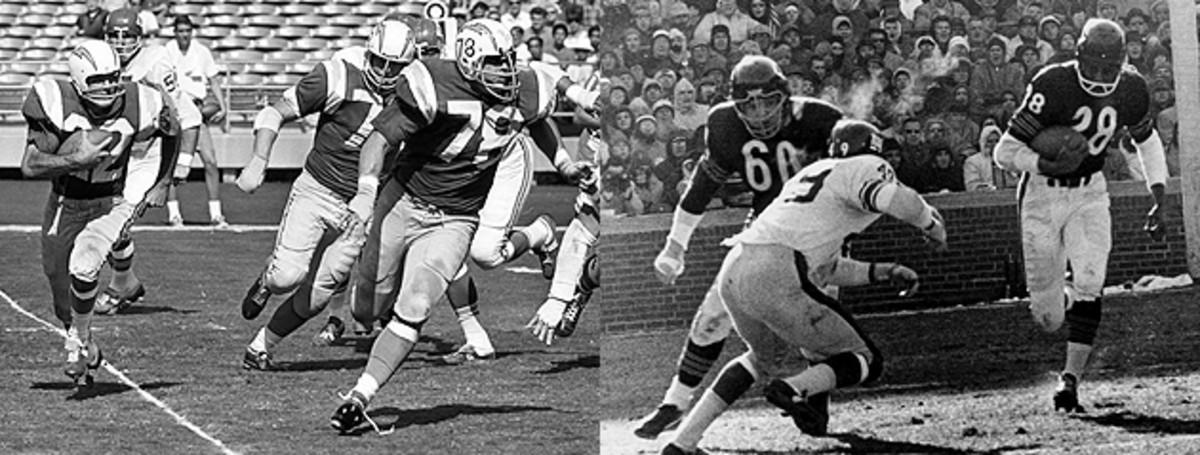
When the American Football League formed in 1960, the basic concept was that the eight-team league would eventually have the horses to compete with the NFL; the “Foolish Club” owners of those teams were men who, for the most part, had been dissuaded from buying their own NFL clubs. How long it took for the AFL and NFL to become true competitive equals was not known. The first two Super Bowls weren’t encouraging for the younger league, though it could be said that the Packers beat the Chiefs and Raiders just as they beat most of their NFL opponents. Super Bowl III, in which the Jets upset the Colts, and Super Bowl IV, when the Chiefs got their measure of revenge in a thwacking of the Vikings, provided the balance necessary for the merger to be the truly balanced move it had to be.
Tom Brady vs. Peyton Manning: The definitive all-time box score
However, there’s one hypothetical AFL-NFL matchup that’s been debated for years, and with good reason. If the 1963 AFL champion Chargers and 1963 NFL champion Bears had met on a neutral site, who would have taken the day?
The answer is not as simple as some NFL propagandists might like to think. Former Sports Illustrated writer Tex Maule was one of those propagandists, and as you might expect, he shot down the idea of the Chargers playing equally with the Bears. In a 1963 SI article titled, “Ridiculous! The NFL by 50 points,” Maule set his statement quite clearly.
“If the champions of the National Football League were to play the champions of the American Football League this year or next, it would be a mismatch that might be compared with the two Sonny Liston-Floyd Patterson heavyweight fights.”
Well, perhaps. But who’s to say that the Chargers might not have been the Cassius Clay of their day, the underdog upstarts who could shock the world?
No question, the 1963 Bears were a great team. As you might expect, they were led by a punishing, physical defense. They allowed just 144 points in their 14 regular-season games and beat the Giants 14–10 in the NFL championship that year. Even before the ascent of Dick Butkus in 1965, Chicago had studs like Doug Atkins and Bill George in the front seven, and defensive backs Richie Petitbon and Roosevelt Taylor led a pass defense that picked off an amazing 36 passes. Chicago’s starting secondary alone had 29 such thefts, which would be an astonishing number in today’s pass-heavy league, never mind back then.
Economists say Rams, Chargers leaving could be good decision
But the Bears were pretty average on offense, and that’s where San Diego would have made the matchup interesting. The Chargers led the AFL in scoring offense and scoring defense, and while one could say that those offensive totals were magnified against less than stellar defenses, that would incorrectly discount the innovations of Chargers head coach Sid Gillman. By 1963, Gillman was running the most complete and diverse offense in professional football, and the Chargers could attack with everything from a full vertical passing game to power running. Yes, quarterbacks Tobin Rote and John Hadl and receiver Lance Alworth lit up the skies, but there were also running backs Keith Lincoln and Paul Lowe. The Chargers trounced the (then Boston) Patriots 51–10 in the 1963 AFL title game, and San Diego amassed 318 yards and four rushing touchdowns on 31 carries. Gillman called for multiple complex run concepts against a Patriots defense that used embryonic versions of today’s multi-front defenses and zone blitz ideas.
“I think Gillman’s Chargers would’ve done very well against the NFL champion Bears,” the late Steve Sabol of NFL Films once said. “I think that [Chargers] team could’ve won. It would’ve been a very interesting matchup between a space-age offense and a stone-age defense.”
We’ll never know, but it would have been one hell of a game.
